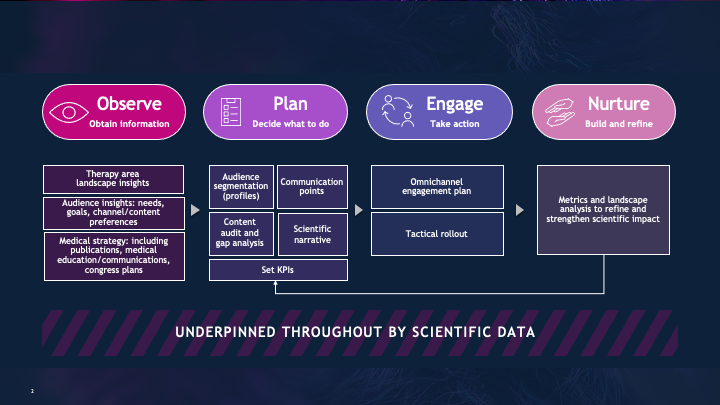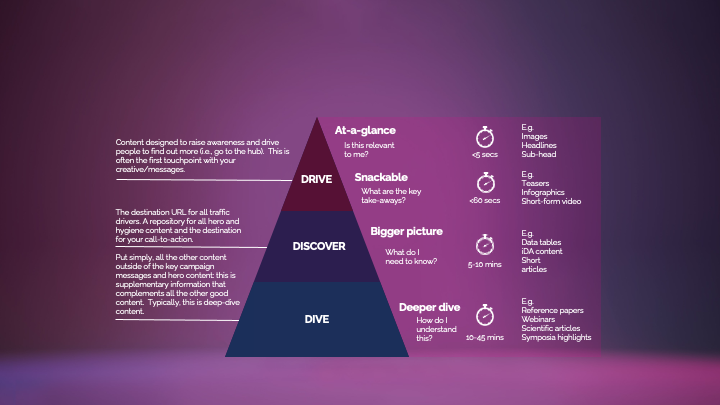Insights / Articles
Introducing an Omnichannel Approach in Medical Affairs
Written by Elin Siddall & Bill McNish on Friday, December 1, 2023
Introduction
The adoption of omnichannel medical affairs strategies has long been discussed, but the reality is that implementation only started in the past year or two. This evolution in healthcare omnichannel can no longer be ignored and now prompts the question of “how” rather than “when.” However, the steps needed to begin implementing an omnichannel healthcare strategy can feel daunting.
It does not have to be like this. With the appropriate set-up, medical omnichannel approaches can be utilized to enhance the inputs and outputs of Medical Affairs planning, including internal collaboration, and measuring changes in awareness, engagement, and education of healthcare professionals (HCPs).
Here is how…
Omnichannel planning in Medical Affairs is a powerful tool
The scope of omnichannel in medical affairs planning and activities aligns with the goal of all Medical Affairs programs of providing robust medical education to support clinical decision-making and improving delivery of healthcare to patients. An omnichannel healthcare approach considers the delivery of complementary, strategically aligned educational resources, with a focus on the channel, content format, and educational preferences of HCPs. By fully integrating these dimensions into the planning and execution of medical education, teams are able to continually address evolving clinical practices and the educational requirements of HCPs.
The origins of medical affairs omnichannel lie in consumer marketing, which serves to generate a seamless consumer journey through a broad range of formats and channels, refined by audience segmentation. Companies utilize data – browsing and purchase histories, survey results, and feedback – for support in understanding their customers better and personalizing each engagement. Amazon or Netflix recommendations, for example, are produced using artificial intelligence (AI)-generated insights that consolidate different types of information from vast volumes of consumer data. Similar basic principles apply when utilizing an omnichannel marketing in healthcare approach, but they are centered around the creation and delivery of targeted education. For this, a key focus is understanding current beliefs, clinical priorities, treatment approaches, and, of course, education and communication needs.
Medical omnichannel plans embrace cross-functional insights to personalize the educational experience
Like many activities within biopharmaceutical companies, communications are optimized through the input of members of a diverse cross-functional team, with critical contributions from across the organization. Medical omnichannel planning embraces the strengths of the wider team – legal, commercial, congress, and publications, to name a few – to support strategic alignment. While most Medical Affairs professionals are very familiar with cross-functional working, an omnichannel process further supports alignment and personalization of approaches to elevate HCPs’ educational experiences.
A typical omnichannel process for Medical Affairs can be distilled into four key steps – Observe, Plan, Engage, and Nurture (Figure 1).

An initial OBSERVE phase generates and collates audience insights through an audit which delves into all aspects of HCPs’ clinical decision-making, including non-prescribing behavior, clinical and practical challenges, knowledge levels, and communication preferences.
This is followed by a PLAN phase, whereby target HCPs are segmented based on their knowledge or non-prescribing behavior to identify relevant educational gaps or needs and develop key informative communication points. To ensure consistency, these communication points should reflect the overarching medical strategy and clinical lexicon.
Next within the Plan phase is a comprehensive channel audit, in which channel specialists use their knowledge and skills to support the cross-functional team in understanding the offerings of a broad range of available channels that specific audiences prefer or use. This may include third‑party media websites and social media.
Following the channel audit, the types of content that audiences prefer are identified through a detailed review of different formats; these types could be as succinct as a social media post or as comprehensive as a manuscript. Omnichannel specialist teams working in the biopharmaceutical space need to simultaneously understand the options available on the different channels and appreciate the guardrails that are necessary for medical activities.
Educational activities developed to meet the needs of a given segment of HCPs should be consistent with their preferences; this includes their sources of information and the formats they use. In addition to ensuring this occurs, omnichannel specialist teams should also continually monitor for and assess opportunities to innovate and consider new channels or tactics.
To ensure all educational content for HCPs is relevant, it is important to consider categorization. Google (specifically on YouTube) categorize their content utilizing a “hero, hub and help” approach.1 This means that every piece of content has a purpose beyond simply existing; it has a meaningful place in a wider information ecosystem. Looking at this through a healthcare lens, utilizing a “drive, discover and dive” approach to categorize HCP content facilitates the creation of purposeful content that forms impactful educational journeys for users (Figure 2).
The preparations made up to this point all contribute toward the ENGAGE phase. This consists of the tactical rollout of the Plan phase and implementation of the engagement strategies.
While the omnichannel approach takes action in the Engage phase, the process is not yet complete; a NURTURE phase allows for analysis and refinement when metrics become available to provide real-time information on how content is being used. Collated metrics may also include variables such as the number of views and the amount of time spent on educational content, as well as the region in which the user was located. From a mid-term perspective, metrics can provide valuable insights to inform the ongoing refinement of activities to optimize operational efficiencies, while continuing to fully meet the evolving educational needs of HCPs.

Does every Medical Affairs activity need an omnichannel plan?
Medical Affairs activities focus on major milestones in the lifecycle of a given therapy. Clinical study readouts or regulatory approval, for example, require HCP education on a wide range of topics.
For example, let’s consider the simultaneous presentation and publication of a Phase 3 study at a major congress. Not every HCP for whom this data set is relevant will attend the congress or read the journal article. Many will look to newsfeeds and social media coverage, while others will seek written or video summaries developed by their peers, plain language content, or infographics. Some HCPs prefer one‑on-one meetings with their Medical Science Liaison, whose role is vital in an omnichannel ecosystem. All these types of communication ultimately reflect the publication and its content, but their format, length, and reading or viewing time are catered to specific audience segments.
Omnichannel planning maximizes the links between content and channels to ensure that each HCP receives the type of content they are seeking. In addition, these links between different resources and channels provide further opportunities to elevate their unique learning experiences.
Omnichannel is a dynamic and evolving approach; what the future has in store is a complex yet interesting question
In omnichannel planning, we recognize that specific metrics shape our understanding of well-used channels and tactics. As the volume of data on these metrics increases, so does our knowledge and understanding about how to ensure that content adaptations remain meaningful to HCPs.
AI technologies form the foundation of activity tracking, content linking, and recommendation generation for Medical Affairs platforms in the same way that they do for Amazon and Netflix. The next step for Medical Affairs is true personalization, which will rely heavily on AI and its ability to collate and interpret vast amounts of data about HCP educational routines and preferences.
Moreover, developing content that is created for a specific HCP segment, channel selection and other methods of engagement may, some day in the future, all be AI led. In the meantime, omnichannel planning in Medical Affairs relies for now on humans (pharmaceutical professionals) and their understanding of HCPs, channels, and content options.
FAQs we get around the Omnichannel Approach:
Q: What specific technology stack and data infrastructure do we need to implement an omnichannel medical affairs strategy? How does this integrate with existing CRM and content management systems?
A: A robust medical affairs omnichannel platform requires integration of:
- Customer data platform
- Content management system
- Analytics and reporting tools
- HCP engagement tracking
- Compliance monitoring systems Implementation typically involves API integration with existing systems while maintaining data privacy and security standards.
Q: How do you measure ROI and success metrics for medical affairs omnichannel initiatives? What benchmarks should we expect?
A: Success metrics typically include:
- HCP engagement rates across channels
- Content consumption patterns
- Knowledge retention and behavior change
- Time to educational goal achievement
- Cost per meaningful engagement Industry benchmarks vary by therapeutic area and market maturity.
Q: What’s the typical timeline and resource investment needed for implementing an omnichannel strategy, from initial assessment to full deployment?
A: Implementation usually follows these phases:
-
- Assessment and strategy development: 2-3 months
- Technology infrastructure setup: 3-4 months
- Pilot program: 2-3 months
- Full rollout: 6-12 months Resource requirements include dedicated team members, technology investment, and content development resources.
Summary
Channel and content options continue to evolve, underpinned by ever-faster advances in technology. Medical Affairs teams are increasingly adopting omnichannel in healthcare strategies; however, for many, implementation is still in its infancy.
The end goal of healthcare omnichannel is personalization of content, but our first step toward this should be working to truly understand the needs of our target audiences and developing more targeted communications based on these insights.
As teams progress in omnichannel medical affairs planning, the exciting challenge for Medical Affairs teams is to stay abreast of new developments and continue to innovate and shape compliant, best-practice communication solutions to serve HCPs.
References
- Marketing Strategies https://www.thinkwithgoogle.co… (accessed November 2023)
Working in partnership with our clients, we embrace our different perspectives and strengths to deliver fresh thinking and solutions that make a difference.
Together we can unlock possibilities.
For information about OPEN Health’s services and how we could support you, please get in touch.